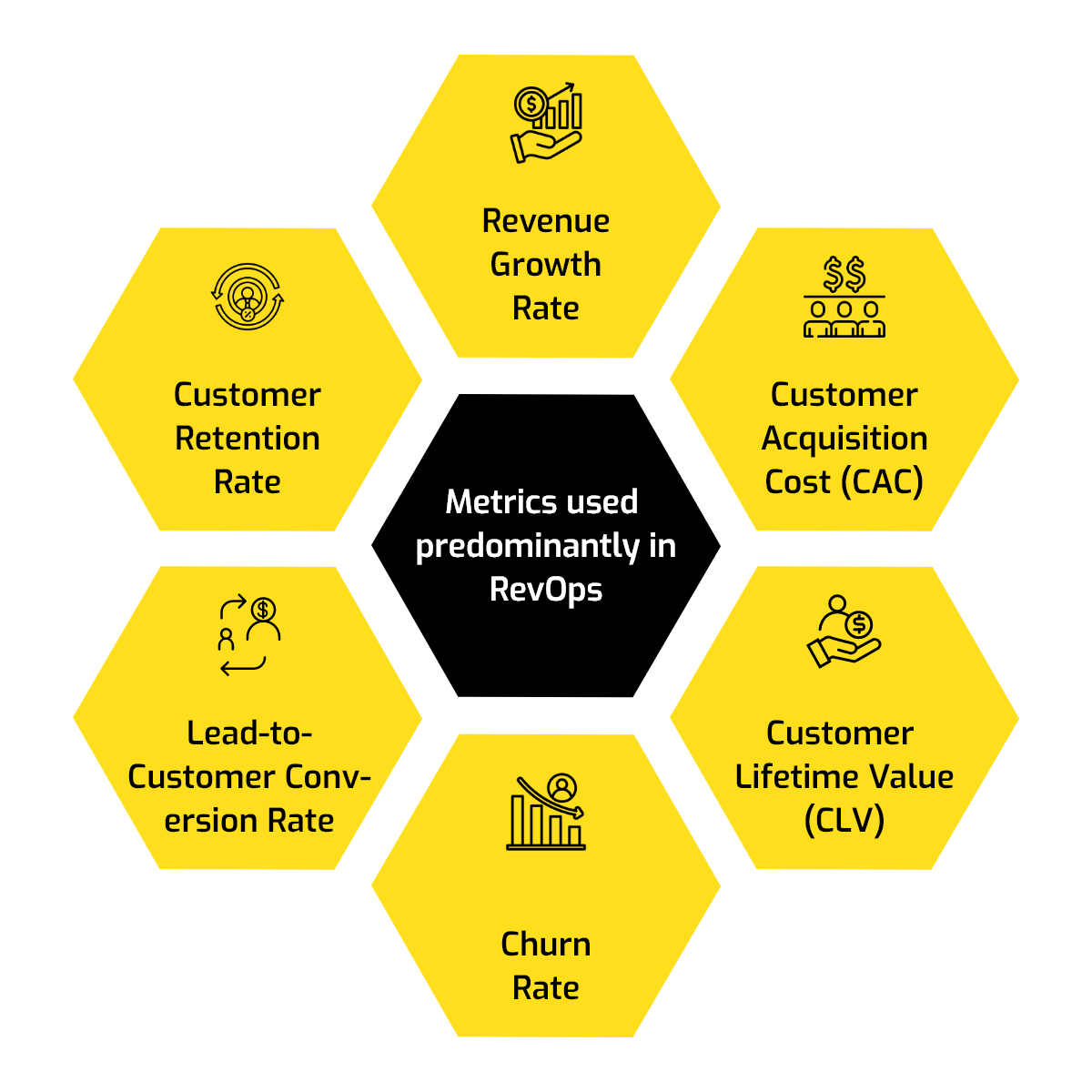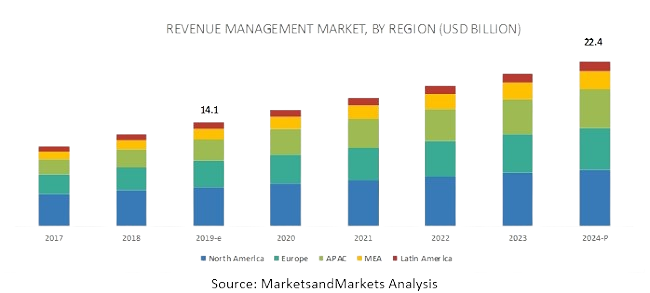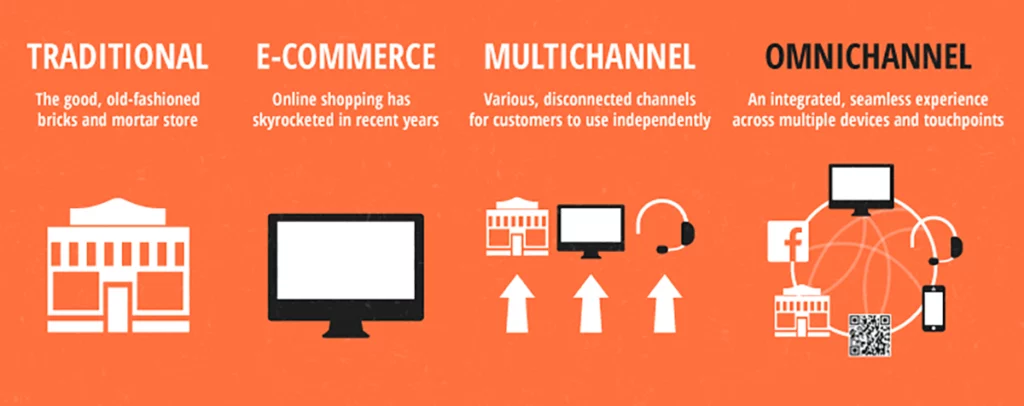What is Revops?
RevOps, short for revenue operations, is a strategic approach that unifies and aligns critical functions within an organization, including sales, marketing, and customer success. Its primary objective is to boost revenue growth while simultaneously enhancing the customer experience.
Key Aspects of RevOps
1. Aiming Integration and Alignment:
RevOps bridges the gaps between traditionally siloed departments. It brings together sales, marketing, and customer success teams, fostering collaboration and shared goals. With shared goals and KPIs, it enables and empowers teams by unifying their understanding of the customer, better measure their efforts and streamline the processes.
By integrating the functions, RevOps truly ensures that everyone is on the same page, working towards common objectives.
2. Setting up End-to-End Revenue Process:
RevOps oversees the entire revenue lifecycle, from marketing efforts that attract potential customers to sales conversions, renewals, and expansion.
It’s not just about closing deals; it’s about managing the entire revenue journey.
3. Transparency and Execution:
Transparency is a cornerstone of RevOps. It provides visibility across the entire revenue team, allowing for informed decision-making. Rigorous execution ensures that processes are efficient, consistent, and aligned with revenue goals.
Imagine, going from:
- Fragmented data
- siloed teams with different goals and KPIs, with no mutual collaboration and no feedback system
- Missed handoffs and broken customer journey
To:
- Well connected marketing, sales and operations teams working towards common goals
- Transparency, visibility, collaboration among teams wth seamless lead flow
- Centralized data, effective reporting
- Data driven insights and decision making
Clearly, with processes optimized for growth, RevOps help businesses scale faster and accelerate their gowth at unpredecented rates.
RevOps Features
Automated Decision-Making
Revenue Leakage Reduction
Data-Driven Opportunities & decision making
Customer Acquisition & Experience Enhancement
Integration between different tools to avoid silos
Revenue Lifecycle Management
When do you feel that your company needs Revops
-
1
Silos among teams:
Employees carrying different approaches create clashes among themselves hence deviating from a common objective.
2Creating a great customer experience:
Many customers drop the brand if they face any challenges with the buying or after sales process.
3Scale your business:
When the process grows, things can fall apart so the current approach doesn't work then, RevOps establishes clear and standardized processes across marketing, sales, and customer success. This creates a well-defined playbook that can be easily replicated as you add team members and scale operations.
4Aligning sales & marketing efforts:
Marketing might generate leads that don't fit the ideal customer profile, leading to wasted sales effort. Sales might struggle to close deals due to a lack of qualified leads or ineffective marketing messaging. This disconnect creates a frustrating experience for everyone involved, and most importantly, hinders growth so it's important to have a perfect harmony among both the teams
Status Quo
Revenue Oprations
Wasted Time and Communication
Data-Driven Collaboration and teamwork
Finger Pointing and handoffs
Transparency and accountability form the boardroom to the front line
Bring-your-own-report
Shared source of truth
Hit or miss forecating
Predictable Business growth
Lone wolf mentality
Higher win rates and faster sales cycles
Overcoming Key Challenges in Implementing RevOps
RevOps implementation can be a transformative journey for any organization, but it's not without its hurdles. Below are some common challenges encountered during the process and strategies to overcome them:
1. Change Can Be Scary: Getting Everyone Onboard
New RevOps plans might involve using different tools, working in new ways, and maybe even a bit of a company culture shift. This can make people hesitant.
Solution: Communicate Benefits to stakeholders about the positive outcomes and benefits of RevOps implementation. Explain how RevOps will make things easier, faster, and ultimately lead to more sales. Provide training to help everyone feel comfortable with the new approach.
2. Inconsistent Information: Breaking Down Data Silos
Siloed data across sales, marketing, and customer success teams can hinder a holistic view of operations. This makes it hard to see the big picture.
Solution: Invest in a unified CRM, accessible to all teams to streamline data management and analysis. & ensure Data Hygiene as accuracy and consistency by regularly updating and maintaining CRM databases.
3. Enhancing Data Quality
Poor data quality undermines the reliability of insights and decision-making processes and also making decision based on messy and outdated information.
Solution: here we can double-check our data and make sure it's accurate. Consider partnering with a data expert to fill in any gaps in marketing, sales data and with reliable information
4. Securing Executive Support
Executive buy-in is crucial for allocating resources and driving organizational change. To secure support from senior leadership:
Solution: Present a strategic roadmap outlining the objectives, timelines, and expected outcomes of RevOps implementation. Also, provide a Business Impact Analysis Demonstrating the potential ROI advantages of embracing RevOps principles.
5. Limited Resources: Making the Most of What We Have
Optimizing Resource Allocation and scale of RevOps initiatives.
- Start Small, Scale Smart: Begin with pilot projects or incremental changes to demonstrate value before requesting additional resources.
- Prioritize Investments: Identify critical areas where resource allocation can yield maximum impact and prioritize accordingly.
6. Achieving Process Alignment
Misaligned processes among sales, marketing, and customer success teams can lead to inefficiencies and inconsistencies.
Solution: To foster alignment:
- Process Standardization: Identify commonalities and best practices across departments, then standardize processes to promote consistency.
- Cross-Functional Collaboration: Facilitate regular meetings and workshops to encourage collaboration and alignment between teams.
7. Promoting Data-Driven decisions
Cultivating a culture of data-driven decision-making requires support and education.
Solution: To foster a data-driven mindset offering tailored training and development programs and resources to enhance data literacy and analytical skills across the organization. Also, encourage leaders to embrace data-driven approaches in their decision-making processes and actively promote its value.
Is Your Revenue Growth Stagnant?
Tech Tools that can Power Up Your Revops
In the realm of Revenue Operations (RevOps), leveraging the right technology is important to succeed. Here's a rundown of essential tools that empower organizations to execute their RevOps strategies effectively:
-
1
CRM (Customer Relationship Management) Systems
Think of a CRM (Customer Relationship Management) system as your team's central hub for all things customer related. It serves as the cornerstone for managing customer relationships, tracking interactions, and automating sales and marketing workflows. A CRM provides a centralized repository of customer data, enabling data-driven decision-making across the organization.
2Marketing Automation Platforms
Marketing automation platforms are like superheroes for repetitive tasks. It automates tasks such as email marketing, social media scheduling, and managing paid advertisements. By automating repetitive tasks, these platforms enhance marketing efficiency and enable teams to focus on strategic initiatives.
3Sales Empowerment Software
Equipping sales teams with the necessary resources to close deals, sales enablement platforms offer access to sales collateral, training materials, and competitive intelligence. These tools empower sales representatives to engage effectively with prospects and drive conversions.
4Insights & Analytics Solutions
Analytics tools are indispensable for monitoring key performance indicators (KPIs), evaluating strategy effectiveness, and uncovering insights into customer behavior. By harnessing data analytics, organizations can refine their RevOps approach, driving revenue growth and improving profitability.
5Workflow Automation Tools/ Operational Efficiency Tools
Workflow automation tools take care of those repetitive, time-consuming areas. These tools automate mundane tasks, freeing up valuable time for teams to focus on high-impact activities. From lead routing to task management, automation tools streamline processes and boost productivity.
6Collaborative Work Platforms
Breaking down organizational silos is essential for seamless RevOps implementation, and collaboration tools are the bridges that connect your sales and marketing teams. By fostering collaboration between sales, marketing, and customer success teams, these tools enhance alignment and drive collective success.
7Data Solutions
In Revenue Operations, the quality of data is paramount to success. Poor data quality can severely impact productivity, and cause mis-outs on sales opportunities, and give a negative impact on marketing resources. Suggestion is to collaborate with a verified data provider to address these challenges effectively.
Book a Free Consult with our RevOps Experts.
Metrics used predominantly in RevOps
- Revenue Growth Rate: This measures the rate at which your company's revenue grows over a specific period. It gives an overall indication of the success of your revenue operations efforts.
- Customer Acquisition Cost (CAC): This metric measures the cost associated with acquiring a new customer. It helps in understanding how efficiently resources are being utilized in the acquisition process.
- Customer Lifetime Value (CLV): CLV predicts the total revenue a business can expect from a single customer over the entire relationship. It's crucial for understanding the long-term value of customers and guiding strategic decisions.
- Churn Rate: Churn rate measures the percentage of customers who stop using your product or service over a given period. High churn can indicate issues with customer satisfaction or retention strategies.
- Lead-to-Customer Conversion Rate: This metric measures the percentage of leads that convert into paying customers. It provides insights into the effectiveness of your marketing and sales efforts in converting leads.
- Customer Retention Rate: This metric measures the percentage of customers retained over a specific period. It provides insights into customer satisfaction and the effectiveness of retention strategies.
Setting up RevOps can include:
- Tech Stack Implementation & Optimization
- Tech Stack Integrations
- Migrations
- Database Cleanup & Hygiene
- Revenue Atttribution
- Reporting & Dashboards setup
- Training & User Adoption
At Transfunnel, we can help you with all the above RevOps services, with the tool of your choice. Being trusted partners for HubSpot, Salesforce, monday.com, Zoho and many other platforms, our experts can help you pick the right tool as per your requirements and also help with implementation and optimization.
Benefits of implementing Revops:
-
Seamless Collaboration:
RevOps breaks down departmental walls, fostering communication and collaboration. Teams share data, insights, and strategies in real-time, leading to more efficient workflows and quicker problem-solving.
-
The Power of One:
RevOps eliminates duplicate efforts and redundant processes. RevOps acts as the conductor, unifying these teams, ensuring everyone plays in harmony towards a common goal – revenue growth.
-
Actionable Insights:
RevOps gathers and analyzes data from all revenue-generating activities. This comprehensive view allows you to identify areas for improvement, optimize campaigns, and tailor strategies based on real customer behavior.
-
Predictable Revenue Growth:
Data-driven decision making with RevOps is like composing a revenue growth symphony. You can accurately forecast sales, optimize pricing strategies, and focus resources on high-performing channels.
Top B2B companies that implemented RevOps experienced accelerated growth and close to 10% to 20% increases in sales productivity, according to Boston Consulting Group Better collaboration between teams and common goals and KPIs, resulted in:
100 - 200%
Whopping Rise in marketing ROI
10 - 20%
Increase in sales productivity
15 - 20%
Rise in customer satisfaction CSAT
30%
Reduced GTM expenses
Source: Boston Consulting Group, 2020
Our Revops Implementation Framework (Process)
1. Laying the Foundation (Evaluation & Planning)
- Analyzing the current business situation: Assess your existing marketing, sales, and customer success processes, tools, and data integration. Identify areas for improvement and potential roadblocks to a unified revenue engine.
- Define Your RevOps Goals: Stating objectives for setting up revenue operations framework. This could increase sales conversion rates, boost customer lifetime value (CLTV), or improve collaboration across revenue teams.
2. Building Your RevOps Team
- Assemble a Cross-Functional Team: Form a dedicated RevOps team with representatives from marketing, sales, and customer success. This team will spearhead the implementation and ensure collaboration across departments.
-
Structure Your RevOps Team (Example for Scaling Businesses):
- Director of Revenue Operations: Reports to the Chief Revenue Officer (CRO) and oversees the overall RevOps strategy.
- Managers: Lead specific areas like Sales Operations, Marketing Operations, Customer Success Operations, and Systems Operations.
- Analysts: Support each area by analyzing data, identifying trends, and collaborating with respective departments.
-
3. Tech Stack Transformation (Integration & Optimization)
- Audit Your Existing Tools: Take stock of the technology stack currently used by each revenue-generating team. Identify any redundancies or gaps that hinder seamless data sharing and collaboration.
- Select & Implement Integrated Tools: Choose and implement RevOps tools that facilitate data flow and collaboration across departments. This may include a CRM system, marketing automation platform, customer success software, and business intelligence (BI) tools.
4. Data-Driven Decisions (Metrics & KPIs)
- Define Success with Key Metrics: Identify the key performance indicators (KPIs) that align with your overall RevOps goals. Examples include CLTV, customer acquisition cost (CAC), sales cycle length, and net promoter score (NPS).
- Establish Measurement Systems: Set up robust systems to track and measure the chosen KPIs. Utilize analytics tools and reporting dashboards to gain real-time insights into performance.
5. Optimizing the Revenue Engine (Processes & Improvement)
- Map the Customer Journey: Develop a clear understanding of your customer's journey, from lead generation to post-sale support. Identify touchpoints and optimize processes to create a seamless and positive experience.
- Standardize Operations (SOPs): Create standard operating procedures (SOPs) to streamline tasks and maintain consistency across departments. This ensures everyone is aligned and working towards the same goals.
6. Continuous Improvement
- Embrace Feedback Loops: Establish mechanisms for gathering feedback from teams on the effectiveness of RevOps strategies. This helps identify areas for improvement and adapt to changing business needs.
- Refine & Adapt: Continuously analyze data, gather feedback, and refine your RevOps processes and strategies. Be prepared to adapt your approach based on ongoing performance and evolving market conditions.
Ready to Overhaul Your Growth Engine with RevOps?
RevOps Trends Over Time
-
- The global Revenue Operations Service market size was valued at USD 182.99 million in 2021 and is expected to expand at a CAGR of 20.99% during the forecast period, reaching USD 573.98 million by 2031.
- Which regions are leading the Revenue Operations Service Market?
- North America (United States, Canada and Mexico)
- Europe (Germany, UK, France, Italy, Russia and Turkey etc.)
- Asia-Pacific (China, Japan, Korea, India, Australia, Indonesia, Thailand, Philippines, Malaysia and Vietnam)
- South America (Brazil, Argentina, Columbia etc.)
- Middle East and Africa (Saudi Arabia, UAE, Egypt, Nigeria and South Africa)
-
The world of RevOps is constantly evolving, adapting to meet the ever-changing needs of the market. Here's a glimpse into some key trends that will shape RevOps strategies in 2024 and beyond:
#1 The Power of AI & Machine Learning Takes Center Stage
The rise of Artificial Intelligence (AI) and Machine Learning (ML) isn't slowing down. Experts predict continued growth in these technologies, impacting various aspects of RevOps. Imagine AI automating tasks like lead scoring, sales forecasting, and campaign optimization, freeing up your team to focus on higher-level strategies. ML can further enhance personalization by analyzing customer data and tailoring experiences across the entire buying journey.
Reference image to be made: According to MarketsandMarkets, the AI market is expected to grow at a 36.8% CAGR from 2023 through 2030.
-
#2 Customers First: Personalization is Key
Today's customers crave personalized experiences. In 2024 and beyond, a customer-centric approach is paramount. Leverage data and insights to personalize messaging, offers, and solutions to individual customer needs and preferences. AI will play a significant role in scaling personalized customer support, ensuring a consistent and relevant experience at every touchpoint.
#3 Omnichannel Engagement: A Seamless Journey
Gone are the days of single-channel marketing. Modern customers navigate a multi-channel world, interacting with brands across various platforms. To stay ahead, prioritize creating an omnichannel and digital strategy. This ensures a consistent and seamless customer experience whether they're on social media, browsing your website, or interacting with your sales team.
Getting Ready for RevOps in 2024.........
As we navigate the ever-evolving landscape of RevOps in 2024, staying ahead of the curve is crucial.
The Revenue Operations movement is here— teams are moving away from wasted time, finger pointing, inaccurate and flawed reporting, to collaboration and data-driven approach, fostering transparency, predictable business growth, and faster deal closures.
Get in touch with us and let us break all the barriers resisting your Business Growth
Explore the Below Value Add Services
Transfunnel has enabled close to 1000+ businesses from 5+ continents by aligning their Marketing & Sales Teams, implementing Marketing Automation and RevOps processes and helped them turn around their Marketing ROI and achieve accelerated growth.









